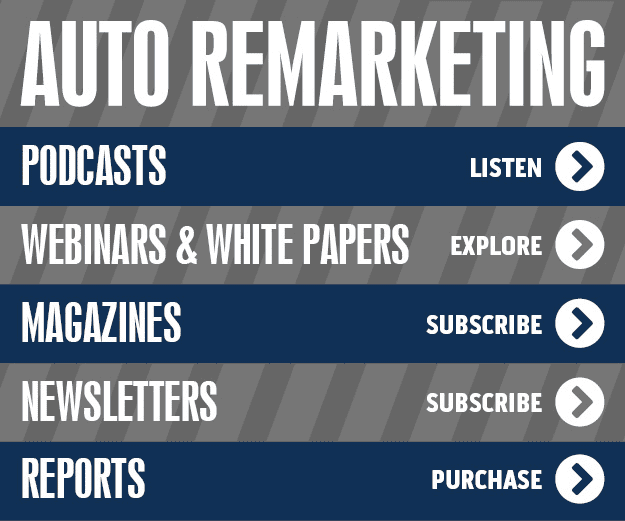3 in 5 Maintenance Plan Customers Likely Remain Loyal to Dealership Long-Term

By subscribing, you agree to receive communications from Auto Remarketing and our partners in accordance with our Privacy Policy. We may share your information with select partners and sponsors who may contact you about their products and services. You may unsubscribe at any time.
DAYTONA BEACH, Fla. –
Dealerships that offer free and pre-paid maintenance plans stand a better chance of retaining their service customers. That’s the word from DMEautomotive, per the results of a new study.
On Monday, DMEa released key findings from its new national consumer survey, which studied more than 2,000 U.S. vehicle owners in April of this year.
The study showed that the best way for dealers to win and retain consumer loyalty is to offer prepaid or complimentary maintenance plans, combined with excellent service delivery. This was especially true among the under-35 customer.
“Our survey provides fresh evidence that both prepaid and OEM-provided maintenance plans have a powerful impact on dealer service retention,” said Doug Van Sach, vice president of Strategy & Analytics at DMEautomotive.
“With nearly three in five consumers reporting they are likely to continue servicing at the dealership after their plan expires — compared to average dealer post-warranty retention rates of 22 to 40 percent, depending on vehicle make and age — these programs can more than double service business that typically bleeds to the aftermarket, while also having a profound impact on retaining the young, traditionally dealer-averse, service shopper’s business,” he said.
Specifically, the DMEa survey noted that 22 percent of American car owners currently have a maintenance plan beyond a standard OEM warranty — 15 percent have a complimentary plan such as ToyotaCare, Experience Buick or BMW Ultimate Service, while 7 percent of respondents have purchased a PPM dealer plan.
Subscribe to Auto Remarketing to stay informed and stay ahead.
By subscribing, you agree to receive communications from Auto Remarketing and our partners in accordance with our Privacy Policy. We may share your information with select partners and sponsors who may contact you about their products and services. You may unsubscribe at any time.
Overall, 56 percent of those with a maintenance plan reported they’re likely to keep servicing at the dealership when their plan expires, the DMEa study showed.

In other findings, the survey showed a link between use of the service plan and customer satisfaction levels.
While 65 percent of respondents reported using their plan for “all” scheduled maintenance, 25 percent have only used it for just “some” of their covered services, indicating that though these consumers hold a free or paid-for plan, they are choosing to spend their service dollars outside the dealership.
Also, DMEa reported, a significant percentage of plan-holders either reported not being consistently engaged by their dealership, or not finding value in their plans. Nine percent of these consumers reported not using their dealer-based maintenance plan at all.
How much consumers use their plans, and whether they exclusively service with that dealer, correlated in the survey with a significantly higher likelihood to continue service with that dealership post-plan, at 62 percent.
Thirty percent of consumers in that group report they’re “very likely” to return to the dealership, compared with 17 percent of those that only have “some” maintenance performed under the plan.
DMEa reported that 69 percent of those with free or PPM plans are either “extremely satisfied” or “satisfied” with the plan; those using their plans for “all” scheduled service at the dealership reported the highest satisfaction levels, with 75 percent either “extremely satisfied” or “satisfied.”
Sixty-six percent of those using their plans for just “some” maintenance, meanwhile, report being satisfied, but only 7 percent are in the “extremely satisfied” category.
By age, the DMEa survey revealed that the under-35 consumer presents the biggest challenge to dealerships in terms of loyalty, but that maintenance plans offer an opportunity to connect with, and retain, them.
Those under 35 were more likely to have a maintenance plan, at 31 percent, compared to those over 35, at 18 percent, and were significantly more likely to use their plans for “all” maintenance than older customers, by a margin of 11 percent.
Those ages 25 to 34 who used their plan for “all” maintenance also reported the highest plan satisfaction of any age group, at 84 percent, with 62 percent reporting they’re likely to continue service at the dealership post-plan.
“It’s imperative that dealers and OEMs offer free and prepaid programs, because more than half of all consumers currently under one indicate they will stay with the dealership post-plan,” noted Van Sach. “Our data did contain some surprises: one in four customers still stray from the dealership while under a plan, and consumers who do not have ‘all’ service performed under the plan are significantly less likely to continue servicing at that dealership.
“So, if dealers or OEMs imagine that under-plan service taken elsewhere just means more profits, or that they don’t need to worry about keeping these customers very close and satisfied until plan expiration, this data clearly shows that those beliefs need some revising.”
Other Industry Findings
Recent related news from within the industry includes an announcement earlier this month from GSFS Group on the launch of its new F&I product, SecureNet Maintenance Plus.
The company said this reinsurable maintenance plan is designed to drive traffic to a dealership’s service department, increasing profits and building dealership loyalty by directing customers back to the dealership where the vehicle was purchased.
Women, meanwhile, represent about two-thirds of service/repair customers, according to results of the recent Women Satisfaction Index Service by Women-Drivers.com, and 53 percent of women intend to have their vehicle serviced at the dealership from which it was purchased.
Finally, research released in June by CNW Research showed that dealership service departments are holding their own in competition with tire and quick-lube shops by offering name-brand tires, special oil change and lube coupons, and drop-in lanes where technicians are paid either a flat rate per vehicle or a smaller per-hour wage.
CNW reported that more than half of loyal service customers return to the same dealer to purchase their next new or used car.


